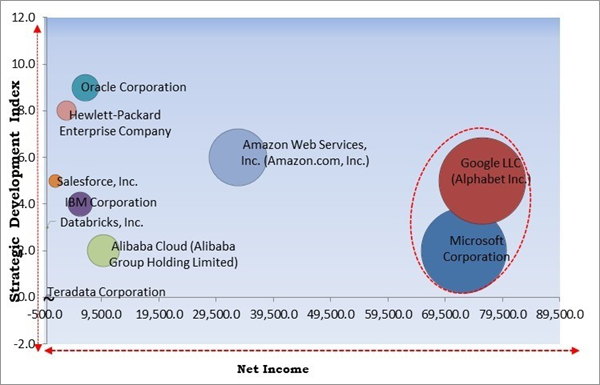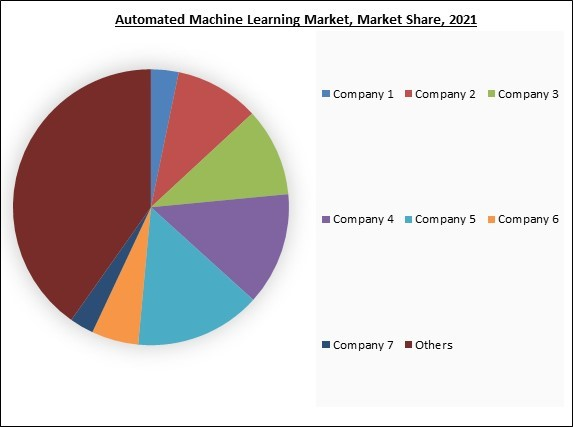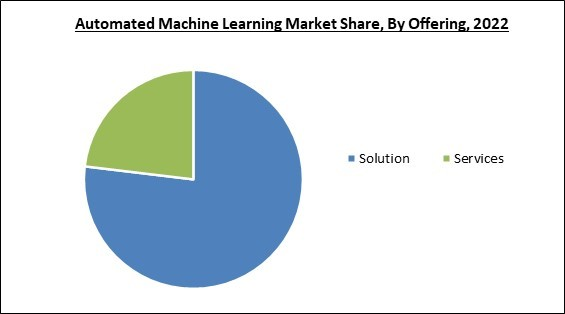The Global Automated Machine Learning Market size is expected to reach $9.1 billion by 2029, rising at a market growth of 42.9% CAGR during the forecast period.
Model selection is one of the major applications of automated machine learning. AutoML tools can expedite the prototyping and iteration phase of machine learning projects. By quickly exploring different models and configurations, data scientists can iterate and refine their models more efficiently. This agility enables faster experimentation and iteration cycles, ultimately accelerating the development of high-quality machine learning solutions. Thereby, Model Selection acquired $111 million revenue in 2022.
The major strategies followed by the market participants are Partnerships as the key developmental strategy to keep pace with the changing demands of end users. or instance, In August, 2022, Alibaba Cloud entered into a collaboration agreement with the Hong Kong University of Science and Technology (HKUST) for supporting the research work of the HKUST researchers, etc. The partnership reflects Alibaba Cloud's commitment to nurturing technology talent and supporting local innovation ecosystems. Additionally, In March, 2023, AWS came into collaboration with NVIDIA for training sophisticated large language models (LLMs) and developing generative AI applications.
The leading players in the market are competing with diverse innovative offerings to remain competitive in the market. The above illustration shows the percentage of revenue shared by some of the leading companies in the market. The leading players of the market are adopting various strategies in order to cater demand coming from the different industries. The key developmental strategies in the market are Partnerships & Collaborations.
The market research report covers the analysis of key stake holders of the market. Key companies profiled in the report include Oracle Corporation, IBM Corporation, Microsoft Corporation, Google LLC (Alphabet Inc.), Amazon Web Services, Inc. (Amazon.com, Inc.), Salesforce, Inc., Hewlett-Packard enterprise Company, Teradata Corporation, Alibaba Cloud (Alibaba Group Holding Limited) and Databricks, Inc.
Model selection is one of the major applications of automated machine learning. AutoML tools can expedite the prototyping and iteration phase of machine learning projects. By quickly exploring different models and configurations, data scientists can iterate and refine their models more efficiently. This agility enables faster experimentation and iteration cycles, ultimately accelerating the development of high-quality machine learning solutions. Thereby, Model Selection acquired $111 million revenue in 2022.
The major strategies followed by the market participants are Partnerships as the key developmental strategy to keep pace with the changing demands of end users. or instance, In August, 2022, Alibaba Cloud entered into a collaboration agreement with the Hong Kong University of Science and Technology (HKUST) for supporting the research work of the HKUST researchers, etc. The partnership reflects Alibaba Cloud's commitment to nurturing technology talent and supporting local innovation ecosystems. Additionally, In March, 2023, AWS came into collaboration with NVIDIA for training sophisticated large language models (LLMs) and developing generative AI applications.
The Cardinal Matrix - Market Competition Analysis
Based on the Analysis presented in the The Cardinal Matrix; Microsoft Corporation, and Google LLC (Alphabet Inc.) are the forerunners in the Market. In May, 2023, Google Cloud extended its partnership with SAP for jointly building the future of open data and AI, and bringing in a full-fledged open data offering developed to make data landscapes easier. This offering allows users to build data could. Companies such as Amazon Web Services, Inc. (Amazon.com, Inc.), Oracle Corporation, and Hewlett-Packard Enterprise Company are some of the key innovators in Market.Market Growth Factors
Growing demand for transforming businesses with intelligent automation
There is a rising need for intelligent business processes as organizations depend increasingly on data to inform decisions and boost operational effectiveness. These procedures use machine learning algorithms to automate decision-making and streamline corporate operations, which boosts productivity and profits. By utilizing AutoML, companies can increase performance, lower costs, and streamline operations, giving them a competitive advantage. In addition, AI-powered automation has been demonstrated to significantly increase productivity. By automating the creation and deployment of machine learning models, the market can assist firms in achieving these types of outcomes.Using potential for quicker decision-making and cost reduction
The AutoML market has enormous potential due to the improved use of machine learning. Machine learning has always required substantial statistics, programming, and data analysis knowledge and has been extremely specialized. Organizations no longer require a staff of data scientists and machine learning specialists to construct and implement AI solutions due to the introduction of AutoML technologies. AutoML technologies, on the other hand, allow businesses to make more accessible use of machine learning, thereby rendering it more available to a wider range of customers and use cases. Furthermore, the democratization of machine learning can help companies expand their offers and tap into new markets, boosting sales and market share.Market Restraining Factors
The adoption of ML tools is slow
A primary restriction impeding the expansion of the AutoML sector is the delayed uptake of these tools. Many businesses are hesitant to implement AutoML despite its many advantages, such as improved productivity, accuracy, and scalability. One of the main causes of this sluggish acceptance is that people are unaware of the automated machine learning (AutoML) market or its capabilities. The adoption of AutoML may be hampered by the fact that many corporate leaders and decision-makers may not be aware of its advantages and the potential effects on their industry. Therefore, it is anticipated that the lack of adoption because of the low implementation cost and the low awareness will impede market expansion.The leading players in the market are competing with diverse innovative offerings to remain competitive in the market. The above illustration shows the percentage of revenue shared by some of the leading companies in the market. The leading players of the market are adopting various strategies in order to cater demand coming from the different industries. The key developmental strategies in the market are Partnerships & Collaborations.
Offering Outlook
Based on offering, the market is segmented into solutions and services. The services segment acquired a substantial revenue share in the market in 2022. Users of autoML services can automate a number of processes involved in creating and implementing machine learning models, including feature engineering, tweaking hyperparameters, model selection, and deployment. These services are created to make it simpler for companies and individuals to utilize the potential of machine learning without needing a deep understanding of or expertise in the subject.Solution Type Outlook
Under the solutions type, the market is bifurcated into platform and software. The platform segment held the highest revenue share in the market in 2022. Business users of all skill levels and organizations of all sizes may quickly and simply use the potential of AI and machine learning to solve challenges due to automated machine learning platforms. Companies from all industries can use these platforms to enhance operations, boost client retention, and pinpoint crucial variables that affect everything from loan default to medical treatment requirements.Application Outlook
On the basis of application, the market is divided into data processing, feature engineering, model selection, hyperparameter optimization & tuning, model ensembling and others. The data processing segment registered the highest revenue share in the market in 2022. Data normalization, cleaning, and transformation are just a few of the many components of data processing that may be automated with the help of autoML. Data mistake detection and correction can be automated using automated machine learning (AutoML). This includes figuring out where values are missing, fixing data formatting issues, and eliminating outliers that can compromise the precision of machine learning models.Vertical Outlook
By vertical, the market is classified into BFSI, retail & ecommerce, healthcare & life sciences, IT & telecom, government & defense, manufacturing, automotive, transportations, & logistics, media & entertainment and others. The BFSI segment led the market by generating the maximum revenue share in 2022. The BFSI sector has recently implemented AI and ML technologies at a faster rate to boost operational effectiveness and enhance the customer experience. The need for machine learning in BFSI applications increases as data receives more attention. With a lot of data, inexpensive computing power, and cheap storage, automated machine learning can generate accurate and quick results.Solution Deployment Outlook
Based on the solution deployment, the market is bifurcated into cloud and on-premise. The cloud segment witnessed the largest revenue share in the market in 2022. Since internet connections have become more dependable and remote work has become more common, cloud computing has become more widely used. In comparison to on-premises systems, cloud-based AutoML solutions are more flexible and scalable since they are simple to scale up or down to match changes in workload or data volume. Additionally, pay-as-you-go pricing is frequently available with cloud-based systems, which can be more economical for businesses with varying workloads.Regional Outlook
Region-wise, the market is analyzed across North America, Europe, Asia Pacific, and LAMEA. The North America region generated the highest revenue share in the market in 2022. The nations in the region rank among the most developed in the world. In the region, the autoML market is expanding quickly. Several major providers are providing a variety of solutions, from fully automated systems to those that help data scientists create machine learning models. The market is being pushed by the need for quicker and more effective ways to develop and deploy machine learning models, as well as a growing need for artificial intelligence solutions across various industries.The market research report covers the analysis of key stake holders of the market. Key companies profiled in the report include Oracle Corporation, IBM Corporation, Microsoft Corporation, Google LLC (Alphabet Inc.), Amazon Web Services, Inc. (Amazon.com, Inc.), Salesforce, Inc., Hewlett-Packard enterprise Company, Teradata Corporation, Alibaba Cloud (Alibaba Group Holding Limited) and Databricks, Inc.
Strategies Deployed in the Market
Partnerships, Collaborations and Agreements:
- May-2023: Google Cloud extended its partnership with SAP, a Germany-based software company. The partnership focuses on jointly building the future of open data and AI and bringing in a full-fledged open data offering developed to make data landscapes easier. This offering allows users to build data could.
- Apr-2023: Oracle extended its partnership with GitLab, a US-based technology company. The collaboration enables users to run AI and ML workloads along with GPU-enabled GitLab runners on the OCI, Oracle Cloud Infrastructure. Further, GitLab's vision for accuracy and speed perfectly aligns with Oracle's goals.
- Mar-2023: AWS came into collaboration with NVIDIA, a US-based software company. The collaboration includes jointly building on-demand AI infrastructure intended for training sophisticated large language models (LLMs) and developing generative AI applications.
- Feb-2023: AWS extended its partnership with Hugging Face, a US-based developer of chatbot applications. The partnership focuses on making AI more accessible and includes making AWS Hugging Face's preferred cloud provider, allowing developers to access tools from AWS Trainium, and AWS INferentia, among others.
- Nov-2022: Microsoft signed an agreement with Lockheed Martin, a US-based company operating in the aerospace and defense industry. The agreement focuses on four key areas for the Department of Defense. The key areas include Artificial Intelligence/Machine Learning (AI/ML), Classified Cloud Innovations, 5G.MIL Programs, Digital Transformation, and Modeling and Simulation Capabilities.
- Oct-2022: Oracle extended its partnership with Nvidia, a US-based manufacturer, and designer of discrete graphics processing units. The partnership involves supporting customers in the faster adoption of AI services. This partnership would lead to delivering both the companies' respective expertise to support clients across various markets.
- Sep-2022: Salesforce extended its partnership with Amazon Web Services (AWS), a US-based provider of cloud-based web platforms. The partnership would enable users to develop personalized AI models through Amazon SageMaker.
- Aug-2022: Alibaba Cloud entered into a collaboration agreement with the Hong Kong University of Science and Technology (HKUST), a public university in Hong Kong. The collaboration involves teaming up on technology research, supporting the research work of the HKUST researchers, etc. The partnership reflects Alibaba Cloud's commitment to nurturing technology talent and supporting local innovation ecosystems.
- Aug-2022: Oracle Cloud Infrastructure came into collaboration with Anaconda, a US-based developer of data science platform. The collaboration focuses on providing secure open-source R and Python tools by incorporating the data science platform's repository across OCI's ML and AI services offerings. Through this collaboration, the companies aim at introducing open-source innovation to the enterprises and support in applying Ai and ML to the users' critical and important business and research initiatives.
- Jun-2021: AWS signed a partnership agreement with Salesforce, a US-based provider of enterprise cloud computing solutions. This partnership would enable users to use Salesforce and AWS' capabilities together to rapidly develop and deploy business applications that would advance digital transformation.
Product Launches and Product Expansions:
- May-2023: Oracle launched OML4Py 2.0. The new ML product features, new data types, and makes available their in-database algorithms, Extreme Gradient Boosting, Exponential Smoothing, and Non-negative Matrix Factorization.
- Mar-2023: Databricks launched Databricks Model Serving, a real-time machine learning intended for the Lakehouse, Databricks' platform. The Model Serving makes the model building and maintenance process easier. The new offering would enable the customers to deploy models and enjoy lower time to production, lowered cost of ownership, and decreased burden.
- May-2021: Google Cloud unveiled Vertex AI, a machine learning platform. Vertex AI is intended for developers, making it easier for them to maintain, and deploy AI models. The newly launched product aims at reducing the time to ROI for the users.
- Feb-2021: Salesforce launched Intelligent Document Automation (IDA) technology intended for the healthcare industry. The new technology supports the users in digitizing their document management processes and is powered by Amazon Textract.
Acquisitions and Mergers:
- Jan-2023: Hewlett Packard took over Pachyderm, a US-based operator of data engineering platform. The blend of HPE and Pachyderm would deliver a combined ML pipeline and platform to advance a customer's journey.
- Jul-2022: IBM took over Databand.ai, a leading provider of data observability software. This acquisition aimed to provide IBM with the most comprehensive set of observability offerings for IT across applications, data, and machine learning and would continue to provide IBM's customers and partners with the technology they require to provide trustworthy data and AI at scale.
- Jun-2021: Hewlett Packard Enterprise completed the acquisition of Determined AI, a San Francisco-based startup. This acquisition aimed to provide a strong and robust software stack to train AI models quicker, at any scale, utilizing its open-source machine learning (ML) platform.
Scope of the Study
By Application
- Data Processing
- Feature Engineering
- Model Selection
- Hyperparameter Optimization & Tuning
- Model Ensembling
- Others
By Offering
- Solution
- Type
- Platform
- Software
- Deployment
- Cloud
- On-premise
- Services
- Type
By Vertical
- BFSI
- IT & Telecom
- Retail & Ecommerce
- Media & Entertainment
- Healthcare & Life Sciences
- Government & Defense
- Manufacturing
- Automotive, Transportations, & Logistics
- Others
By Geography
- North America
- US
- Canada
- Mexico
- Rest of North America
- Europe
- Germany
- UK
- France
- Russia
- Spain
- Italy
- Rest of Europe
- Asia Pacific
- China
- Japan
- India
- South Korea
- Singapore
- Malaysia
- Rest of Asia Pacific
- LAMEA
- Brazil
- Argentina
- UAE
- Saudi Arabia
- South Africa
- Nigeria
- Rest of LAMEA
Key Market Players
List of Companies Profiled in the Report:
- Oracle Corporation
- IBM Corporation
- Microsoft Corporation
- Google LLC (Alphabet Inc.)
- Amazon Web Services, Inc. (Amazon.com, Inc.)
- Salesforce, Inc.
- Hewlett-Packard enterprise Company
- Teradata Corporation
- Alibaba Cloud (Alibaba Group Holding Limited)
- Databricks, Inc.
Unique Offerings
- Exhaustive coverage
- The highest number of Market tables and figures
- Subscription-based model available
- Guaranteed best price
- Assured post sales research support with 10% customization free
Table of Contents
Chapter 1. Market Scope & Methodology
Chapter 2. Market Overview
Chapter 3. Competition Analysis - Global
Chapter 4. Global Automated Machine Learning Market by Application
Chapter 5. Global Automated Machine Learning Market by Offering
Chapter 6. Global Automated Machine Learning Market by Vertical
Chapter 7. Global Automated Machine Learning Market by Region
Chapter 8. Company Profiles
Companies Mentioned
- Oracle Corporation
- IBM Corporation
- Microsoft Corporation
- Google LLC (Alphabet Inc.)
- Amazon Web Services, Inc. (Amazon.com, Inc.)
- Salesforce, Inc.
- Hewlett-Packard enterprise Company
- Teradata Corporation
- Alibaba Cloud (Alibaba Group Holding Limited)
- Databricks, Inc.












